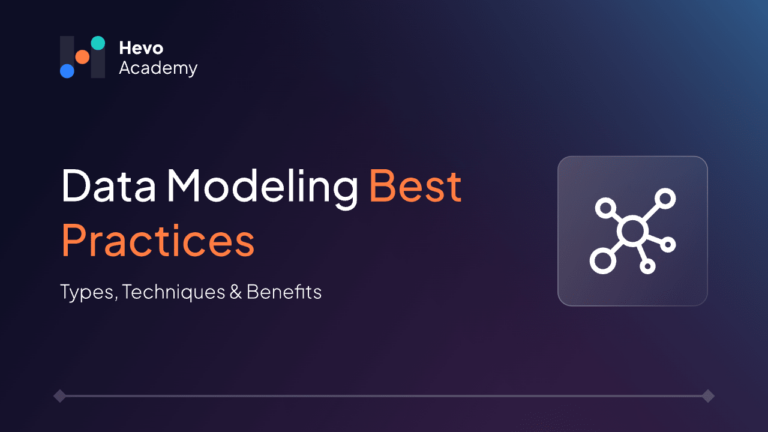Any data is useless if it cannot bring value to business. Many software development activities fail in the early stages due to poor database designs. This results in huge losses to businesses even before they are started. It explains how important proper data modeling is. Data modeling is a stepping stone for establishing data systems that generate value. By creating data models teams can organize, analyze, and interpret data very efficiently.
Table of Contents
A well-designed data model increases quality, brings clarity, optimizes performance, and ensures scalability for future requirements. In this article, we discuss what data modeling is, the types of data models, data modeling best practices to establish these data models, and how Hevo can simplify the data modeling and integration process.
What is Data Modeling?
Data modeling is a process of creating graphical representation around data structure, and relation between those data models. It is a technique where you design and create a database from scratch. It is about how data can be transformed to best reflect the information. Data modeling is where functional business requirements are visible as data models.
A good data model should be able to answer all these questions.
- What data is required?
- What relationships exist between different data elements?
- What constraints and rules apply to the data?
- How will the data be accessed and used?
- How does the model align with business objectives?
- How is the data structured?
Why Do You Need Data Modeling?
Data Modelling is very important to structure, organize, and understand data. Read about the techniques of data modeling that every organization should know. Let’s discuss major reasons to consider using data modeling.
- Improved data integrity: Data models set clear relationships between data entities. This helps to avoid any errors while writing or using the data.
- Reduced redundancy: While creating data models, we tend to avoid any duplicate data. They give clarity to identify any redundant data, set rules, and stop it right before storing it. This helps in improving database performance and reduces storage costs.
- Improved data accessibility: A well-organized structure of data models facilitates easy access and quicker navigation through data entities. This enables developers to effortlessly locate the information they require for analysis and reporting purposes.
- Streamlined database design: Data models assist developers in creating effective database structures with a clear insight into data relationships. Data Modelling provides this clarity and hence can help optimize database design.
- Scalability: Data models bring clarity to design them in such a way that they can accommodate future data growth.
- Compliance with regulations: Structured models can help establish clear governance regulations and data privacy rules.
Types of Data Model
Let us discuss three types of data models that are widely used for data modeling. Read about how to create a data model in detail.
Conceptual Data Model
Conceptual data model represent data on top view abstract level. This type of model focuses on identifying entities and their relationships. It represents data on the business function level. By looking at conceptual data model documentation, teams can easily understand business data flow.
For example, in the below diagram, we see that an e-commerce application conceptual data model will have models based on functional units like sales, products, inventory orders, etc.

Logical Data Model
The logical data model represents the relationship between data elements in a graphical fashion. This includes defining entity types, attributes, keys, and relationships. Logical data models are created by taking the data descriptions from the conceptual model and adding more context and definitions.
For example, this layer for an e-commerce application will define all the data elements required for their data types to actually contain all the information related to this functional unit.

Physical Data Model
After the logical model, physical data models take description one level deeper. It represents the internal schema of a database, including tables, columns, data types, views, constraints, indices, and procedures. Physical data models can be used to generate tables and databases DDL to replicate them on the database server.
For example, in an e-commerce use case, the physical layer will depict the relationship between entities.

Top 10 Data Modeling Best Practices
As we discussed different types of data models, let us now see what are the top 10 data modeling best practices.
1. Start with the Business Requirements
- Why it matters: Data modeling must align with the organization’s goals. A model that doesn’t meet business needs risks being irrelevant or even counterproductive.
- Example: If an e-commerce business wants to track customer purchasing patterns, the data model should include tables for customers, orders, products, and transactions, with relationships clearly defined to support metrics like “average order value” or “repeat purchase rate.”
- How to approach:
- Gather input from stakeholders across departments.
- Define data requirements such as tables, relationships, and key performance indicators (KPIs).
2. Collaborate Across Teams
- Why it matters: Collaboration ensures the data model addresses diverse requirements, minimizes misunderstandings, and fosters ownership among all stakeholders.
- Example: A retail company might have its sales team requesting data on daily transactions, while the finance team needs monthly revenue trends. Collaboration ensures the model supports both perspectives by structuring the data accordingly.
- How to approach:
- Conduct workshops or brainstorming sessions with representatives from IT, data, and business teams.
- Use tools like Lucidchart or Visio for visualizing data structures during discussions.
3. Use Consistent Naming Conventions
- Why it matters: Inconsistent naming creates confusion, reduces readability, and complicates data governance.
- Example: Instead of naming a table
cust_infoin one part of the model andcustomer_detailsin another, standardize the naming to something likecustomers. - How to approach:
- Use a consistent format, such as
<Entity>_<Descriptor>(e.g.,Order_Details,Product_Info). - Publish a naming convention guide for team-wide adherence.
- Use a consistent format, such as
4. Normalize Data
- Why it matters: Normalization reduces redundancy and ensures data integrity.
- Example: Instead of storing the customer address in every transaction record, create a
Customerstable with address details and reference it via aCustomerIDin theTransactionstable. - How to approach:
- Apply normalization rules (1NF, 2NF, 3NF) while balancing against performance needs.
- Avoid over-normalization for operational systems where speed is critical.
5. Document Your Data Model
- Why it matters: Documentation acts as a reference for developers, analysts, and future team members, reducing knowledge gaps and streamlining maintenance.
- Example: Create a document explaining that the
CustomerIDin theOrderstable references theCustomerIDin theCustomerstable, along with the reason for the foreign key. - How to approach:
- Use tools like Dataedo or ER/Studio for automated documentation.
- Include information about each table, column, and its purpose.
6. Validate and Iterate
- Why it matters: A static data model might quickly become obsolete if not aligned with evolving business needs.
- Example: A logistics company realizes that its existing model doesn’t account for return shipments. Iteration adds a
Returnstable with proper relationships. - How to approach:
- Conduct regular reviews of the data model against new business requirements.
- Use test datasets to validate query performance and data integrity.
7. Optimize for Performance
- Why it matters: Poorly optimized models lead to slow query performance, high storage costs, and user frustration.
- Example: For a reporting system, add indexes to columns frequently used in
WHEREclauses, such asOrderDatein theOrderstable. - How to approach:
- Use indexing for frequently queried columns.
- Optimize relationships to minimize the number of joins for critical queries.
8. Plan for Scalability
- Why it matters: Organizations grow, and so do their data needs. A scalable model avoids costly redesigns in the future.
- Example: A streaming service initially tracks only user subscriptions but anticipates adding user activity tracking. Design the model with separate tables for subscriptions and activity logs, with room for new columns or tables.
- How to approach:
- Use partitioning for large tables to handle increasing data volume.
- Consider sharding strategies for distributed databases.
9. Prioritize Data Security
- Why it matters: Data breaches and non-compliance can lead to significant legal, financial, and reputational damage.
- Example: Encrypt sensitive fields like
SocialSecurityNumberorCreditCardNumberin theCustomerstable. - How to approach:
- Implement role-based access controls (RBAC).
- Use data masking for sensitive fields in development environments.
10. Leverage Automation Tools
- Why it matters: Automation reduces manual effort, minimizes errors, and helps enforce standards consistently across the organization.
- Example: Use tools like dbForge to auto-generate ER diagrams and validate relationships between tables.
- How to approach:
- Automate schema validation to detect inconsistencies.
- Use tools like SQL Developer or PowerDesigner for model visualization and maintenance.
Conclusion
In this article, we discussed data modeling, different types of data models, and some of the data modeling best practices to implement them. Data modeling is the foundation for effective data management. If implemented with data modeling best practices it can offer great clarity and structure to your complex data systems.
Hevo with its out-of-the-box features can help businesses harness the full potential of their data by providing a platform for easy implementation. Schedule a personalized demo with Hevo for effortless data integration.
FAQs
1. What are the 5 steps under data modeling?
The five steps of data modeling include defining business requirements, identifying relationships, creating conceptual, physical, and logical models, validating the models, and refining them.
2. What are the 4 types of data modeling?
Four types of data modeling techniques are the conceptual data model, logical data model, physical data model, and dimensional data model.
3. What are the key principles of data modeling?
Key principles of data modeling include
– Alignment with business objectives.
– Ensuring data accuracy and integrity.
– Normalization for efficiency.
– Documenting and validating models.
– Planning for scalability and security.






